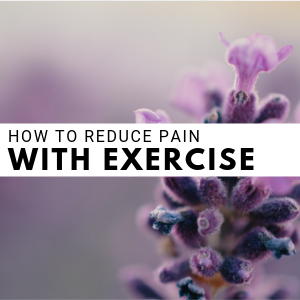09 May How to Reduce Pain with Exercise
Often, with back or joint pain the thought of increasing or doing any physical activity sounds torturous. However, recent studies show that people who exercise and stay flexible manage their pain much better than those who don’t. Keep reading to learn more about how to reduce pain with exercise.
The America Heart Association, Center for Disease Control and many other health organizations recommend 2.5 hours of moderate to intense exercise/activity every week. That breaks down to about 20-30 minutes each day.
How can you reduce pain with exercise?
When you are inactive, your muscles can get stiff, which can decrease your strength and your mobility. This can make chronic pain worse. A recent study discussed the ways that pain can be decreased with physical exericise, concluding that any amount of activity is preferable to sedentary behavior. In other words, even minimal activity can have rewards when it comes to reducing your pain.
Try these simple exercises to safely start reducing your pain.
- Lie on your back on a carpeted floor or mat. Rest your legs on a couch, chair or ottoman, so that your legs from the heels to the back of your knees are completely supported. This puts you in the same position as sitting in a chair, only now the pressure on your back is displaced.
- Tip: Place an ice pack underneath your back if you feel pain while doing this.
- Using a stability ball, lie face down on the ball and let your body mold to the sides of the ball.
- Lie on your back and pull your knees to your chest. This is called the “happy baby” pose. If this feels okay, try rocking back-and-forth and side-to-side to message your back muscles.
- Try walking on a treadmill or elliptical machine if you have access to a gym. You can also use a stationary bike (one that supports your back) as another way to exercise.
- Walk to and from your mailbox if you don’t have access to a gym. Making an extra trip everyday will slowly help you to increase your stamina.
What else can you do to reduce pain?
- Always seek advice from your doctor, physical therapist or trainer before starting any new diet or exercise regimen. They know your current level of pain and can customize a workout plan based on your physical condition.
- If any exercises increase your pain, STOP immediately.
- Always ice any painful areas before and after exercising or stretching. Ice helps to reduce inflammation, the cause of a lot of increased pain with exercise.
- The more sitting around you do, the worse your pain will become due to inactivity and stiffness.
Remember, STOP IMMEDIATELY if an exercise worsens your pain. ALWAYS seek advice from your doctor, physical therapist or trainer before starting a new exercise regimen.
 For more information on The Pain Management Group, please visit thepainmanagementgroup.com or schedule an appointment at one of our locations throughout Middle Tennessee.
For more information on The Pain Management Group, please visit thepainmanagementgroup.com or schedule an appointment at one of our locations throughout Middle Tennessee.
We are committed to providing individualized care and vow to treat each patient with compassion and respect, never turning anyone away. Our physicians are fellowship-trained pain specialists who utilize a combination of interventional procedures and medication management services to tailor a personalized care plan for each patient’s long-term pain relief.





